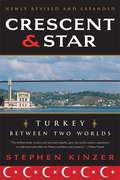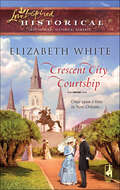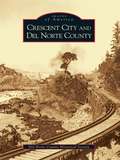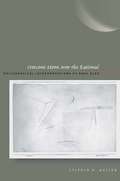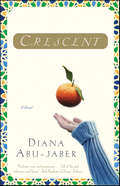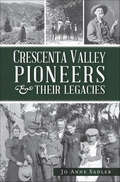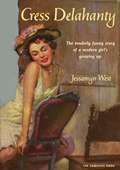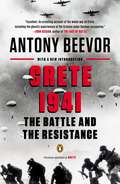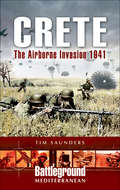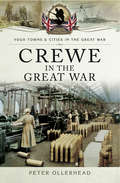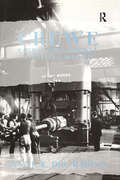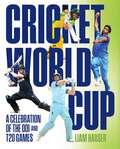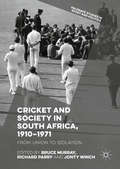- Table View
- List View
Crescent And Star: Turkey Between Two Worlds
by Stephen KinzerIn the first edition of this widely praised book, Stephen Kinzer made the convincing claim that Turkey was the country to watch -- poised between Europe and Asia, between the glories of its Ottoman past and its hopes for a democratic future, between the dominance of its army and the needs of its civilian citizens, between its secular expectations and its Muslim traditions. In this newly revised edition of Crescent and Star, he adds much important new information on the many exciting transformations in Turkey's government and politics that have kept it in the headlines, and also shows how recent developments in both American and European policies (and not only the war in Iraq) have affected this unique and perplexing nation.
Crescent City Courtship
by Elizabeth WhiteAbigail Neal dreams of someday escaping her life in the slums of New Orleans. But how can a woman alone and unprotected ever fulfill her dreams of becoming a doctor? Then, young medical student John Braddock comes to pay a call on a neighbor. Though the scars left on her heart have taught her never to trust anyone, Abby is drawn to John's caring nature. Soon an unlikely friendship develops between the son of privilege and the poor daughter of missionaries. But when Abby's mysterious past comes back to haunt her present, will she call upon her faith to help right a wrong and make a new life with her very own Prince Charming?
Crescent City Girls
by Lakisha Michelle SimmonsWhat was it like to grow up black and female in the segregated South? To answer this question, LaKisha Simmons blends social history and cultural studies, recreating children's streets and neighborhoods within Jim Crow New Orleans and offering a rare look into black girls' personal lives. Simmons argues that these children faced the difficult task of adhering to middle-class expectations of purity and respectability even as they encountered the daily realities of Jim Crow violence, which included interracial sexual aggression, street harassment, and presumptions of black girls' impurity. Simmons makes use of oral histories, the black and white press, social workers' reports, police reports, girls' fiction writing, and photography to tell the stories of individual girls: some from poor, working-class families; some from middle-class, "respectable" families; and some caught in the Jim Crow judicial system. These voices come together to create a group biography of ordinary girls living in an extraordinary time, girls who did not intend to make history but whose stories transform our understanding of both segregation and childhood.
Crescent City Rhapsody
by Kathleen Ann GoonanKathleen Ann Goonan's first novel, Queen City Jazz, propelled her into the front ranks of speculative fiction. Her lyrical and imaginative renderings of a near future transfigured by the wonders and dangers of nanotechnology provide readers tantalizing glimpses of scientific advances just beyond the cutting edge...and the unpredictable human consequences following in their wake. Now comes Goonan's most ambitious, penetrating look yet into the exotic future already flowering around us--and perhaps within us.<P> It begins with silence. A powerful electromagnetic pulse high in the atmosphere triggers a communications blackout, causing electronics and computers to fail the world over. In that moment of anachronistic quiet, a brilliant astronomer named Zeb Aberly, scouring the heavens with equipment of his own design, makes the discovery of a lifetime: the pulse originated in space--and it carried a message from an intelligent source. But Zeb is not alone. Shadowy forces within the government seek to decipher the message and to keep its existence secret at all costs. Fleeing for his life into the back streets and alleys of Washington, D.C., Zeb embarks on an odyssey that could cost him his family, his sanity, and everything he loves.<P> And it begins with murder. In New Orleans, mob boss Marie Laveau--a descendant of the famous voodoo priestess--is brutally gunned down by nameless, faceless enemies. But Marie's vast wealth has purchased the best life insurance of all: resurrection. Reborn by means of nanotechnology, Marie discovers that her husband and young daughter were also hit, their bodies too badly damaged to be repaired. Now she will stop at nothing to track down and punish those responsible. But her quest will lead beyond vengeance, into the very technology that saved her...and a conspiracy linked to the mysterious event now known as the Silence.<P> Recurring at unpredictable intervals, the Silence renders electronic-based technology unreliable and dangerous. A substitution must be found before civilization collapses; breakthroughs in nanotech and advances in genetic engineering give hope of a new kind of communication in the future. But now, as babies born around the world in the months following the first Silence grow to adulthood, demonstrating uncanny physical and mental characteristics that bring suspicion and violence, nanotech plagues unleashed by ecoterrorists and fearful governments wreak havoc on an already panicked populace.<P> The eye of the apocalyptic storm is a radically transformed New Orleans, where Marie Laveau works feverishly to build a safe haven for the hunted and oppressed, gathering the best and the brightest to build her utopia dream. But time is running out. With the military might of a new and repressive world order ranged against her, Marie's only hope lies in the most dangerous piece of nanotechnology ever devised: A technology capable of saving the human race--or destroying it.It begins with silence. A powerful electromagnetic pulse high in the atmosphere triggers a communications blackout, causing electronics and computers to fail the world over. In that moment of anachronistic quiet, a brilliant astronomer named Zeb Aberly, scouring the heavens with equipment of his own design, makes the discovery of a lifetime: the pulse originated in space--and it carried a message from an intelligent source. But Zeb is not alone. Shadowy forces within the government seek to decipher the message and to keep its existence secret at all costs. Fleeing for his life into the back streets and alleys of Washington, D.C., Zeb embarks on an odyssey that could cost him his family, his sanity, and everything he loves.
Crescent City and Del Norte County
by Del Norte County Historical SocietyThe rugged coastline and wild rivers of Del Norte County were once home to the Yurok and Tolowa Indians, who built their dwellings with planks cut from virgin redwood. The Klamath River was an early supply route to the gold mines, but its treacherous waters were soon abandoned in favor of the ocean port at Crescent City. Although its lighthouse guided many heavily laden ships to safe harbor, famous shipwrecks still lie off Del Norte's rocky coast. Pack mule teams streamed east, bound for mining camps, and ranches in the Smith River and Elk Valleys developed to supply them. River salmon became a major industry, and later the ocean's bounty supported fishermen. Redwood groves fed a thriving timber industry for over a century. Never lacking in drama, Del Norte's history includes a U.S. oil tanker sunk by a Japanese submarine in 1941 and, in 1964, a tsunami that swept through Crescent City, destroying almost all of its downtown.
Crescent Moon over the Rational
by Stephen H. WatsonWhy, and in what manner, did artist Paul Klee have such a significant impact on twentieth-century thinkers? His art and his writing inspired leading philosophers to produce key texts in twentieth-century aesthetics, texts that influenced subsequent art history and criticism. Heidegger, Adorno, Benjamin, Merleau-Ponty, Lyotard, Sartre, Foucault, Blanchot, Derrida, and Marion are among the philosophers who have engaged with Klee's art and writings. Their views are often thought to be distant from each other, but Watson puts them in conversation. His point is not to vindicate any final interpretation of Klee but to allow his interpreters' different accounts to interact, to shed light on their and on Klee's work, and, in turn, to delineate both a history and a theoretical problematic in their midst. Crescent Moon over the Rational reveals an evolving theoretical constellation of interpretations and their questions (theoretical, artistic, and political) that address and continually renew Klee's rich legacies.
Crescent in the Sky (Mechanical Sky #1)
by Donald MoffittThis science fiction fantasy novel features &“an intriguing premise—the Islamic conquest of space—and an engagingly ingenuous hero.&” (Library Journal) Abdul Hamid-Jones is under orders to help the Emir of Mars travel to the holy city of Mecca, a task that will all but assure Emir&’s position as Caliph of the Muslim empire. But developing a fast, safe mode of interplanetary travel is a challenge no one has solved yet, least of a young scientist like Hamid-Jones. But this difficulty is nothing compared to the danger he encounters once caught in a web of court politics that puts his very life on the line.
Crescent: A Novel
by Diana Abu-Jaber"Abu-Jaber's voluptuous prose features insights into the Arab American community that are wisely, warmly depicted."—San Francisco ChronicleSirine, the heroine of this "deliciously romantic romp" (Vanity Fair) is thirty-nine, never married, and living in the Arab-American community of Los Angeles. She has a passion for cooking and works contentedly in a Lebanese restaurant, while her storytelling uncle and her saucy boss, Umm Nadia, believe she should be trying harder to find a husband. One day Hanif, a handsome professor of Arabic literature, an Iraqi exile, comes to the restaurant. Sirine falls in love and finds herself questioning everything she thought she knew about Hanif, as well as her own torn identity as an Arab-American.
Crescenta Valley Pioneers & Their Legacies
by Jo Anne SadlerTheir names run deep through local history and lore, adorning street signs, canyons, historical buildings, homes and ranches in the swath of suburbia between Pasadena and Tujunga, where the towns of La Crescenta and La Ca ada took shape, along with the unique community of Montrose. Profiled in the pages of Crescenta Valley Pioneers and Their Legacies by author Jo Anne Sadler, a researcher and frequent writer for the Historical Society of the Crescenta Valley, are such singularly important local characters as Theodor Pickens, the first permanent settler; Dr. Benjamin B. Briggs, the founder of La Crescenta; Jacob L. Lanterman and Adolphus W. Williams, the original developers of Rancho La Ca ada; and the Le Mesnager family, whose historic wine barn still stands in Deukmejian Wilderness Park.
Cresheim Farm: An American History of Conquest, Privilege and Struggles for Freedom and Equality (Sociology Re-Wired)
by Antje Ulrike MattheusThis book is a work of political archaeology. It focuses on the people and events at a particular colonial farm in Germantown, Pennsylvania; their stories provide a micro and macro view of economic, social, demographic, and agro-ecological change. Cresheim Farm shows how one mostly unknown but strategically placed piece of land—home to an extraordinary array of people, including early anti-slavery and anti-Nazi activists, the first woman editor of the Saturday Evening Post and a robber baron—can tell, affect and reflect the history of a nation. The writing is historically grounded and academic, future-oriented, deeply researched, and immediate. Cresheim Farm serves as a lens through which to observe and understand social forces, such as the launching point of freedom and democracy movements, white privilege, slavery, and genocidal westward expansion. The past lives on in all of us.
Cress Delahanty (Contemporary Classics By Women Ser.)
by Jessamyn WestThe tenderly funny story of a modern girl's growing up.Cress Delahanty, growing up on a California ranch, might have been you at sixteen, your teenage daughter or niece, or the girl next door. You will watch her progress, as her parents did, with amusement and an occasional touch of exasperation and a twinge of heartache at the memory of your own growing pains.She's the girl who invented Delahanty's Law for Saving Time. The high-school kid who decided craziness would be her trademark. The love-smitten adolescent who found a unique way to attract the boys.Not since Penrod--that classic by another Indiana author--has the magic, the humor and the seriousness of adolescence been so warmly and sympathetically portrayed in an American novel."An enchanting novel...those still capable of feeling the absurdity and the beauty of growing up will find it a book well worth treasuring in that library of libraries, the heart."--CLIFTON FADIMAN, The book-of-the-Month Club News"Cress Delahanty has all the makings of a classic."--Hartford Courant"An extraordinarily engaging, humorous and touching book about a teenage girl."--The New York Times"It does for an adolescent girl what Salinger's Catcher in the Rye did for her male counterpart."--Los Angeles Mirror
Crested Butte
by Crested Butte Mountain Heritage Museum Duane Vandenbusche Gunnison Pioneer Museum Crested Butte Mountain ResortCrested Butte rises 8,885 feet above sea level on the edge of the beautiful Elk Mountains in the Gunnison Country of Colorado's Western Slope. Between Crested Butte and Aspen, 25 miles to the north, are six 14,000-foot-high peaks with 12,000-foot-high passes and scenery that takes the breath away. Crested Butte began as a silver camp but soon turned into one of the great coal towns of the West, with a rich ethnic heritage evolved from the mining camps. In the 21st century, Crested Butte is a tourist town of 1,500 residents highlighted by the Mount Crested Butte Ski Area, the Mountain Bike Hall of Fame, and its wonderful wildflower and music festivals. The town today is what it always has been, "the queen jewel of the Elk Mountains."
Crestline Chronicles
by Rhea-Frances TetleySituated in the beautiful San Bernardino Range, Crestline is the gateway community to the famous mountain resorts of Lake Arrowhead and Big Bear Lake. Historically, the area was known for timber-cutting, hunting and fishing, fruit and nut harvesting and, later on, skiing and other winter sports. The first visitors to the area were Native Americans escaping the Mojave Desert summers; followed in the 1850s by Mormon lumberjacks who built San Bernardino Town at the base of the mountains; and then successors who bought the sawmills and settled into mountain living. In these stories of Crestline's formative times, historian Rhea-Frances Tetley recalls some of the more intrepid and colorful characters to have trekked through the western San Bernardinos.
Creston
by Dianne R. OsmunCreston sprang to life on the summit of the high prairie, where railroad officials pitched their camp one night in 1868. Creston was chosen as the division point between the Mississippi and the Missouri Rivers. The railroad brought its machine shops; roundhouse, and a rip-roaring, brawling construction camp to the new town. By 1869, the area was platted and construction began. Creston became an overnight industrial and transportation center, earning the nickname of "Little Chicago." In 1879, Robert Louis Stevenson implied that the Wild West began in Creston. He reported his first encounter with the open display of handguns in Creston when a passenger, without a ticket, was thrown from a moving train. He later wrote, "They were speaking English all around me, but I knew I was in a foreign land. It was the first indication that I had come among revolvers, and I observed it with some emotion."
Crete 1941
by Antony BeevorThe bestselling author of Stalingrad and D-Day vividly reconstructs the epic WWII struggle for Crete - reissued with a new introduction. Nazi Germany expected its airborne attack on Crete in 1941 to be a textbook victory based on tactical surprise. Little did they know that the British, using Ultra intercepts, had already laid a careful trap. It should have been the first German defeat of the war when a fatal misunderstanding turned the battle around. Prize-winning historian and bestselling author Antony Beevor lends his gift for storytelling to this important conflict, showing not only how the situation turned bad for Allied forces, but also how ferocious Cretan freedom fighters mounted a heroic resistance. Originally published in 1991, Crete 1941 is a breathtaking account of a momentous battle of World War II.
Crete 1941
by Howard Gerrard Peter AntillOsprey's study of Operation Mercury, the German airborne assault on the island of Crete in May 1941 during World War II (1939-1945), which was the first strategic use of airborne forces in history. The assault began on 20 May, with landings near the island's key airports, and reinforcements the next day allowed the German forces to capture one end of the runway at Maleme. By 24 May, the Germans were being reinforced by air on a huge scale and on 1 June Crete surrendered. This book describes how desperately close the battle had been and explains how German losses so shocked the Führer that he never again authorised a major airborne operation.
Crete: The Airborne Invasion, 1941 (Battleground Mediterranean)
by Tim SaundersThe invasion was launched to round off Hitlers Balkan Campaign against Crete in May 1941. The Island was important to Britains control of the Eastern Mediterranean and Churchill was determined that the Island would be held.The British garrison was largely made up of New Zealand and Australian troops who had been evacuated from Greece, with little more that what they stood up in. On the other hand the German Commander, Kurt Student, had overwhelming air superiority, which negated the Allied naval superiority. But the Germans had almost fatally underestimated the number of Allied troops.While British, New Zealand and Australian soldiers, however, showed what they were capable of, the battle for Crete was eventually won through sheer nerve, the confidence of the German soldier in his superiority and the power of the Luftwaffe. That said, the cost in killed and wounded was such that Hitler would never again contemplate another large airborne operation.
Crete: The Battle and the Resistance
by Antony BeevorAcclaimed historian and best-selling author Antony Beevor vividly brings to life the epic struggles that took place in Second World War Crete - reissued with a new introduction.'The best book we have got on Crete' ObserverThe Germans expected their airborne attack on Crete in 1941 - a unique event in the history of warfare - to be a textbook victory based on tactical surprise. They had no idea that the British, using Ultra intercepts, knew their plans and had laid a carefully-planned trap. It should have been the first German defeat of the war, but a fatal misunderstanding turned the battle round. Nor did the conflict end there. Ferocious Cretan freedom fighters mounted a heroic resistance, aided by a dramatic cast of British officers from Special Operations Executive.
Crete: The Battle and the Resistance
by Antony BeevorAcclaimed historian and best-selling author Antony Beevor vividly brings to life the epic struggles that took place in Second World War Crete - reissued with a new introduction.'The best book we have got on Crete' ObserverThe Germans expected their airborne attack on Crete in 1941 - a unique event in the history of warfare - to be a textbook victory based on tactical surprise. They had no idea that the British, using Ultra intercepts, knew their plans and had laid a carefully-planned trap. It should have been the first German defeat of the war, but a fatal misunderstanding turned the battle round. Nor did the conflict end there. Ferocious Cretan freedom fighters mounted a heroic resistance, aided by a dramatic cast of British officers from Special Operations Executive.
Cretomania: Modern Desires for the Minoan Past (British School At Athens - Modern Greek And Byzantine Studies #3)
by Nicolett a Momigliano and Alexandre FarnouxSince its rediscovery in the early 20th century, through spectacular finds such as those by Sir Arthur Evans at Knossos, Minoan Crete has captured the imagination not only of archaeologists but also of a wider public. This is shown, among other things, by its appearance and uses in a variety of modern cultural practices: from the innovative dances of Sergei Diaghilev and Ted Shawn, to public and vernacular architecture, psychoanalysis, literature, sculpture, fashion designs, and even neo-pagan movements, to mention a few examples.Cretomania is the first volume entirely devoted to such modern responses to (and uses of) the Minoan past. Although not an exhaustive and systematic study of the reception of Minoan Crete, it offers a wide range of intriguing examples and represents an original contribution to a thus far underexplored aspect of Minoan studies: the remarkable effects of Minoan Crete beyond the narrow boundaries of recondite archaeological research.The volume is organised in three main sections: the first deals with the conscious, unconscious, and coincidental allusions to Minoan Crete in modern architecture, and also discusses archaeological reconstructions; the second presents examples from the visual and performing arts (as well as other cultural practices) illustrating how Minoan Crete has been enlisted to explore and challenge questions of Orientalism, religion, sexuality, and gender relations; the third focuses on literature, and shows how the distant Minoan past has been used to interrogate critically more recent Greek history.
Crewe in the Great War (Your Towns & Cities in the Great War)
by Peter OllerheadAlong with most of the United Kingdom the railway town of Crewe was affected in many ways during the four years of the Great War. The struggle brokered conflict and co-operation in this industrial community planted in the rural acres of Cheshire by the Grand Junction Railway Company in 1843. A military tradition dating back to the town's earliest decades helps to explain the eager response by the young men of Crewe when war was declared in 1914. A rapid increase in the cost of living along with accusations of blatant profiteering soon generated demands for regular wage rises. This conflict between organised labour and industrial and commercial management was more marked in Crewe than elsewhere in the region. Other features of wartime Crewe that are covered in this book are conscription, Zeppelin scares, food shortages, rationing, regular biographical details of those that were killed, the Christmas truce of 1914, influenza epidemics and the division of opinion over a suitable war memorial. These are just some of the issues that affected Crewe during the troubled years of the Great War.
Crewe: Railway Town, Company And People, 1840-1914
by Diane K. DrummondThis is an important contribution to the new urban history, describing and analysing one of the best examples of a company town in nineteenth-century Europe. This archetypal railway town was built on a green-field site by a railway company in 1842-3. It was a major junction, an administrative centre and an important manufacturing centre. Thus it provides an ideal arena in which to study the relationship between company and people and the effects of this claustrophobic association on emerging economic and social structure and politics in the era of large-scale development and modernisation in Europe and America. Dianne Drummond applies the full range of modern urban-historical approaches in this work. It is a shining example of the ways in which new techniques in research, analysis and comparison can redraw the best-known histories. It will be essential reading for urban historians.
Cricket World Cup
by Liam HauserA wonderful time capsule of cricket history, this is a fully illustrated history of the Cricket World Cup since 1975 by acclaimed sports writer Liam Hauser.Celebrating the sport's peak competition since 1975, acclaimed sports writer Liam Hauser, author of The Immortals of Australian Cricket, examines each tournament across both One Day International and Twenty20 formats, including extensive coverage of World Cup semi-finals and finals, and detailing memorable moments and key performances such as hat-tricks, five-wicket hauls, and sparkling centuries. This book is a wonderful time capsule of cricket history. It illustrates how the game developed a new peak competition in limited-over formats over the past five decades– from 60- and 50-over one-day internationals in the 1970s to popular Twenty20 tournaments in the 2000s. Supported by essential stats and wonderful photos of the era, Cricket World Cup is an indispensable resource for cricket enthusiasts and will proudly occupy a place on every sporting tragic's bookshelf.
Cricket and Society in South Africa, 1910–1971: From Union To Isolation (Palgrave Studies in Sport and Politics)
by Richard Parry Bruce Murray Jonty WinchThis book explores how cricket in South Africa was shaped by society and society by cricket. It demonstrates the centrality of cricket in the evolving relationship between culture, sport and politics starting with South Africa as the beating heart of the imperial project and ending with the country as an international pariah. The contributors explore the tensions between fragmentation and unity, on and off the pitch, in the context of the racist ideology of empire, its ‘arrested development’ and the reliance of South Africa on a racially based exploitative labour system. This edited collection uncovers the hidden history of cricket, society, and empire in defining a multiplicity of South African identities, and recognises the achievements of forgotten players and their impact.
Cricket for Schools (J. T. Hankinson on Sport)
by J. T. HankinsonOriginally published in 1946, this was primarily a cricket book for schools and contained much that was new at the time. It was written by a schoolmaster, produced in a school, and a unique feature was that the action photographs are of boys who were at that time in the school team. The author had been coaching school cricket of all grades, Junior Games, House Games, and 1st XI teams for about 20 years, and was at the time of publication in charge of the cricket at Canford School, which, for a relatively small school, had recently produced some very good sides and players. In this book his methods are analysed in a style felt likely to commend itself to readers of all ages.There are 97 action photographs to illustrate the author’s teaching.While this book was primarily for schools, the instructional detail and the attractiveness of the photographs would also have appealed to more mature cricketers and the book was strongly recommended to all who are interested in the game. Today it can be enjoyed in its historical context.
